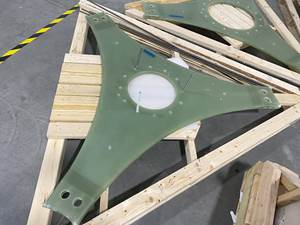From the Publisher - 11/1/2007
I’ve been in the field a lot lately, and I’ve sensed a ground swell of activity around carbon fiber. End users tell me they are not having the difficulty getting fiber (with the possible exception of 3K) that they experienced at this time last year. And the future supply looks even better. This is no big surprise:
I’ve been in the field a lot lately, and I’ve sensed a ground swell of activity around carbon fiber. End users tell me they are not having the difficulty getting fiber (with the possible exception of 3K) that they experienced at this time last year. And the future supply looks even better. This is no big surprise: Every major carbon fiber producer is investing big money in capacity expansion. (See “Carbon fiber producers ….” in “Related Content” at left, for details about announced expansions.) The largest international carbon fiber producer, Japan’s Toray Industries — alone — will have nearly 50 million lb of nameplate capacity by 2009. That is only 10 million lb short of meeting the total worldwide demand recorded in 2006. But such increases will be necessary to meet demand that is projected to grow from 12 to 15 percent per year for the next decade.
It seems that companies from Canada, China, India and Saudi Arabia are sizing up entry into the carbon fiber market as well. While at the China Composites Expo in Beijing last month, I discovered that the northern coastal city of Dalian, a center for emerging technology and international outsourcing, has produced two carbon fiber producers: Xingke Carbon Fiber Co. and Sinosteel Jilin Shezhou Carbon Fiber. Each claims to be making 1K, 3K, 6K, 12K and heavy tow. Scott Stephenson and I met with a representative of Dalian Xingke who claims the company holds several patents in areas of manufacturing technology. We found info on two other Chinese companies gearing up to produce fiber usually for their own use.
Although these producers are starting small with million-pound-or-less capacity lines, they have big plans. Last week the China Daily reported that a delegate to the 17th National Congress of the Communist Party of China from the port city of Lianjungang announced that the Yingyou Group has a carbon fiber production facility there that plans to produce 22 million lb annually by 2010. They also intend to become a regional powerhouse in the production of windblades.
Our “Market Outlook” feature on aircraft production in China (see “Boeing, Airbus fuel ….” in “Related Content,” at left) provides a great compilation of the manufacturing partnerships that Boeing, Airbus and other aircraft manufacturers have established with Chinese aerospace companies to produce both composite and metal parts. Although Boeing and Airbus have slightly different strategies in China, it is clear that China is becoming a major producer of aerospace composites, with production of critical primary structure on the horizon.
I think this unprecedented new capacity bodes well for our industry. I know there are those who fear we could be heading for another cycle of excess capacity and falling profits like we’ve experienced in the past. But adequate capacity and stable pricing may well open the door to the applications we’ve been courting for so long but lose every time demand from the aerospace market jumps and fiber prices soar. These applications represent immense potential — manufacturing of offshore oil drill pipe alone could require millions of lb of fiber every year. Then there are huge wind blades, infrastructure applications and unnumbered industrial applications, not to mention the big need in the automotive industry to lightweight its vehicles and improve fuel economy.
While we’re on the subject of carbon fiber, don’t forget that COMPOSITESWORLD’s Carbon Fiber Conference is coming up December 5-7 in Washington. DC. There is still plenty of time to register. We’re looking forward to seeing old friends there and meeting new people from around the globe who have a stake in the future of carbon fiber.
See you there.
Related Content
We4Ce infused 2.5-3-MW rotor blade design passes validation test
Composite rotor blade structure design by We4Ce, mold and prototype production by InDutch Composites and fatigue testing by Suzlon Group has resulted in the novel blade’s IEC61400-5:2020 certification.
Read MoreSRI develops scalable, infiltration-free ceramic matrix composites
Work in two DOE projects is demonstrating C/C-SiC produced in 3-5 days with <5% shrinkage, <10% porosity and 50% the cost of conventional C/C and C/C-SiC.
Read MoreCeramic matrix composites: Faster, cheaper, higher temperature
New players proliferate, increasing CMC materials and manufacturing capacity, novel processes and automation to meet demand for higher part volumes and performance.
Read MoreRTM, dry braided fabric enable faster, cost-effective manufacture for hydrokinetic turbine components
Switching from prepreg to RTM led to significant time and cost savings for the manufacture of fiberglass struts and complex carbon fiber composite foils that power ORPC’s RivGen systems.
Read MoreRead Next
Ultrasonic welding for in-space manufacturing of CFRTP
Agile Ultrasonics and NASA trial robotic-compatible carbon fiber-reinforced thermoplastic ultrasonic welding technology for space structures.
Read MoreCeramic matrix composites: Faster, cheaper, higher temperature
New players proliferate, increasing CMC materials and manufacturing capacity, novel processes and automation to meet demand for higher part volumes and performance.
Read MoreNext-gen fan blades: Hybrid twin RTM, printed sensors, laser shock disassembly
MORPHO project demonstrates blade with 20% faster RTM cure cycle, uses AI-based monitoring for improved maintenance/life cycle management and proves laser shock disassembly for recycling.
Read More








